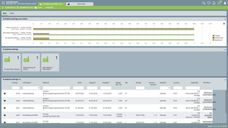Dosing of children's medicine
Simcyp well placed to capitalize on House of Lords drug testing report
Advertisement
A report published by the House of Lords EU Sub-Committee on Social Policy and Consumer Affairs has highlighted that 90% of medicines given to newborn babies have only been tested on adults, and that half of drugs given to children have not been tested adequately in children. The Committee was reporting on the European Commission's proposals for paediatric medicines and their attempts to set up a common EU-wide procedure for testing and approving medicines for use in children.
This is a longstanding issue, and one which has been a focus of attention within Simcyp Limited, a Biofusion spin-out company from the University of Sheffield, which specialises in the development of software that assists the pharmaceutical industry in predicting the behaviour of drugs and new drug candidates in the body.
Traditionally drug dosages for babies and young children were simply scaled down from those in adults based on body weight or body surface area. Dr Trevor Johnson, of Simcyp and the Sheffield Children's Hospital, has shown that this approach may result in up to 3-fold under or over dosing.
Simcyp Paediatric, a module within the Simcyp Interaction and Clearance software platform, used by most of the major global pharmaceutical companies, analyses developmental changes that affect the handling of drugs in neonates, infants and children, to assist in the establishment of safe and effective doses. By using Simcyp Paediatric, pharmaceutical companies will be able to predict doses that should result in drug exposure similar to that in adults.
Most read news
Other news from the department research and development
These products might interest you

Image Integrity Checker by Cytiva
Image integrity checker software - authenticate your images for publication
Safeguard and verify your image data with our free software

Limsophy by AAC Infotray
Optimise your laboratory processes with Limsophy LIMS
Seamless integration and process optimisation in laboratory data management

ERP-Software GUS-OS Suite by GUS
Holistic ERP solution for companies in the process industry
Integrate all departments for seamless collaboration

Get the life science industry in your inbox
By submitting this form you agree that LUMITOS AG will send you the newsletter(s) selected above by email. Your data will not be passed on to third parties. Your data will be stored and processed in accordance with our data protection regulations. LUMITOS may contact you by email for the purpose of advertising or market and opinion surveys. You can revoke your consent at any time without giving reasons to LUMITOS AG, Ernst-Augustin-Str. 2, 12489 Berlin, Germany or by e-mail at revoke@lumitos.com with effect for the future. In addition, each email contains a link to unsubscribe from the corresponding newsletter.

























































